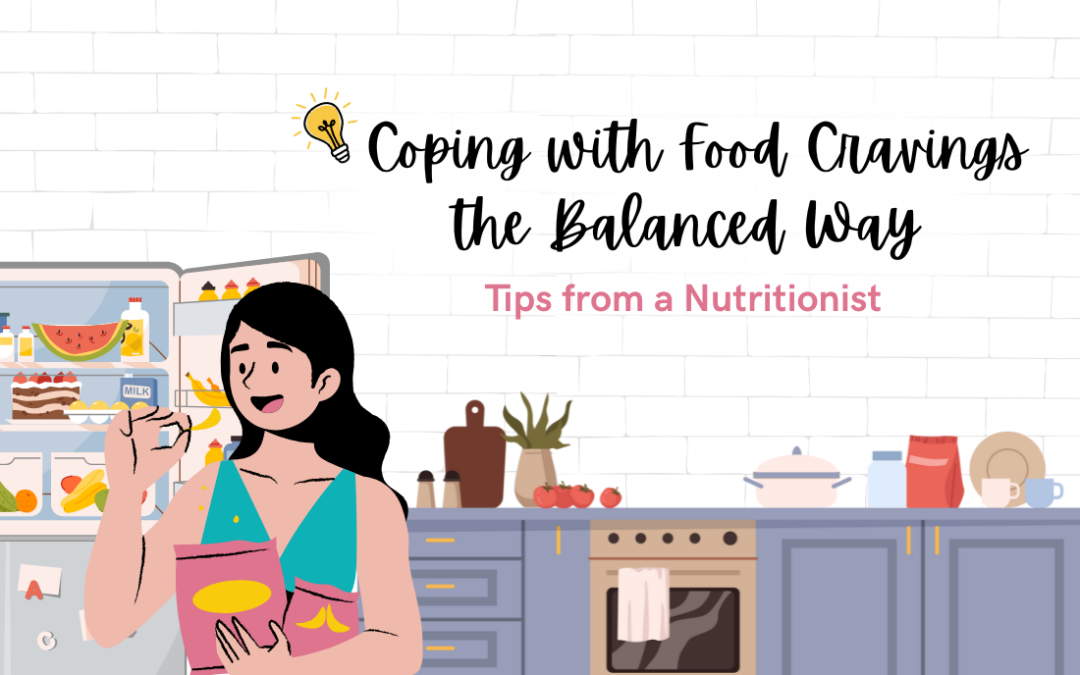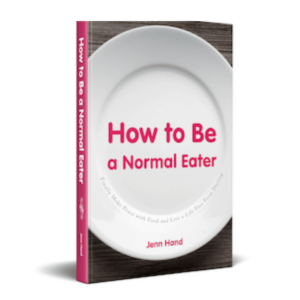Coping with food cravings can feel frustrating, especially when they seem to come out of nowhere.
Written by Jenn Hand, Holistic Nutritionist, Board Certified Health Coach, NBC-HWC
Coping with food cravings isn’t about willpower.
It’s about understanding why cravings happen and having simple strategies to manage them.
One of the best ways I’ve managed food cravings is by focusing on balance rather than restriction.
This can seem counter intuitive to our brains, especially if we want weight loss or we feel out of control around food. But when we eat regular meals with a balance of protein and carbs, cravings diminish and feel less overwhelming.
Instead of fighting and white-knuckling cravings, we focus on fuelling our bodies regularly and often, softening our food rules and adding protein to each meal.
Over time, this helps brings cravings back into balance.
My approach to managing food cravings isn’t about restriction—it’s about balance. The best way I’ve found to reduce cravings is to make sure I’m eating enough throughout the day, adding protein to each meal and snack, and eating satisfying and nutritious foods to keep my blood sugar stable.
Over the course of my own journey, I found that when I was truly satisfied, allowing foods, and not restricting, cravings naturally become less intense.
And I was able to enjoy treats in moderation without guilt and anxiety.
📖 Related Read: How to Figure Out What to Eat So You Feel Nourished and Satisfied
But Wait, Why Do Food Cravings Happen in the First Place?
Food cravings can be triggered by a mix of biological, emotional, and habitual factors.
On a biological level, cravings may stem from imbalances in blood sugar, inadequate food intake, or a lack of protein rich foods, which help keep you full. Emotionally, stress, boredom, or sadness can lead to cravings for comfort food as a way to self-soothe.
Habitual cravings often come from repeated eating patterns—like always reaching for something sweet after dinner. Understanding the root cause of your cravings can help you respond in a balanced and mindful way.
Is There a Difference Between Hunger and Food Cravings?
Yes! Hunger is your body’s signal that it needs fuel, while food cravings are often driven by emotions, habits, or specific food associations.
True hunger builds gradually and can be satisfied with a variety of foods, including healthy snacks, while cravings tend to be sudden and specific (think chocolate, chips, or sugary treats). Restriction can impact this, though, since deprivation can cause increased food cravings and hunger at the same time. Emotional cravings happen when we want to use food for a reason.
We seek comfort, reward, numbing out, soothing, etc. Tuning into your body’s cues—like hunger levels, energy, and mood—can help you determine whether you’re actually hungry, feeling an emotion, or simply craving a specific taste or texture.
How Mood and Stress Affect Food Cravings
When stress levels rise, so do cravings for unhealthy foods, especially those high in sugar and fat.
Cortisol, the stress hormone, can trigger the desire for quick digesting sugar (usually sweets or simple carbs!) as your body seeks fast energy.
Emotional eating patterns also play a role—many people turn to comfort food when they feel anxious, overwhelmed, or lonely. To manage cravings, try mindful breathing, a short walk, or journaling before automatically reaching for food.
Finding non-food ways to soothe stress can help you stop emotional eating.
What used to work for me in the moment was to step away from the situation to ground myself. I would go outside, leave the table for a minute, go upstairs, escape to the bathroom, etc.
By doing this, I could tune into what I actually needed and wanted.
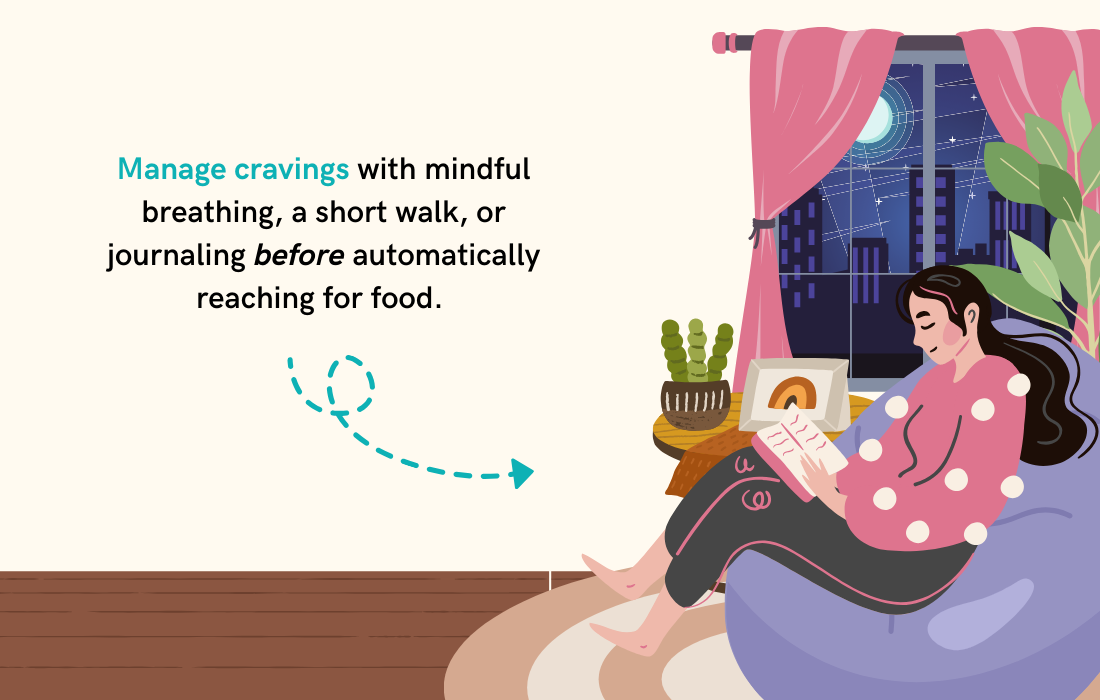
7 Tips to Cope with Food Cravings
1. Eat Balanced to Prevent Food Cravings
In my work as an emotional eating coach, I always work to help my clients eat balanced.
The diet mindset can be sneaky! Skipping meals, “saving up for,” or eating too little can set you up for stronger cravings later in the day.
A well-balanced diet that includes protein, fiber, and healthy fats helps regulate blood sugar and keep cravings at bay. If you’re frequently craving sweets, it may be a sign that you need more variety, higher enjoyment of what you’re eating, and/or more protein at each meal.
2. Stay Hydrated with Water and Electrolytes
Dehydration can sometimes be masked as hunger, leading to unnecessary cravings.
Drinking enough water throughout the day, along with electrolytes from sources like coconut water or mineral-rich foods, helps maintain proper hydration. Before reaching for a snack, try drinking a glass of water—you might find that your craving disappears.
Water is something I often struggle with, so I have to make an effort on this one!
3. Get Enough Sleep If You Want to Curb Food Cravings!
This might sound cliche, but it’s true!
Not getting enough sleep can throw off hunger hormones, leading to increased food cravings, especially for high-calorie, unhealthy foods. Aim for at least 7-9 hours per night, as poor sleep can make it harder to control control emotional eating.
If you’re constantly reaching for sugary or carb-heavy snacks, consider whether pure exhaustion is playing a role.
4. Choose Nutrient-Dense Foods That Truly Satisfy You
Filling your meals with nutrient-dense, whole foods—like vegetables, lean proteins, and whole grains—can help keep cravings in check.
These foods support stable energy levels and prevent blood sugar dips that trigger cravings. Instead of restricting certain foods, focus on adding nourishing options that naturally reduce cravings over time.
5. Allow Yourself to Enjoy Foods Without Guilt
This sound like it contradicts #4, but it’s equally as important!
Trying to completely cut out foods backfires, leading to binge eating or obsessive thoughts about food.
A piece of chocolate or a slice of pizza won’t derail your weight loss or health goals—learning to eat them without guilt is key to a balanced approach. We can still have a balanced approach to food and allow ourselves to eat what we enjoy in moderation.
6. Delay for a Few Minutes
When a craving strikes, pause for a moment and check in with yourself.
I used to set a timer to help me with this. I’d set a timer for 10-15 minutes and check in with myself. Was I actually hungry or just feeling stressed, bored, or emotional?
Taking a few minutes to reflect—maybe drinking a glass of water, stretching, or doing a quick task—can help you determine whether it’s a true hunger signal or just a fleeting urge.
7. Distract Yourself with an Enjoyable Activity
Some people think that distraction is a cop out, as we should “sit through and process” the craving or the emotion.
But sometimes, we just need a good ole fashioned distraction! Physical movement, even just a short walk or a few stretches, can help shift your focus and reduce cravings. Exercise releases endorphins, which can naturally curb emotional eating and improve your mood.
If you’re stuck in a cycle of food cravings, try moving your body, cleaning out a closet, calling a friend, googling trips for your next vacation, or get lost in a good novel instead of immediately reaching for a snack.
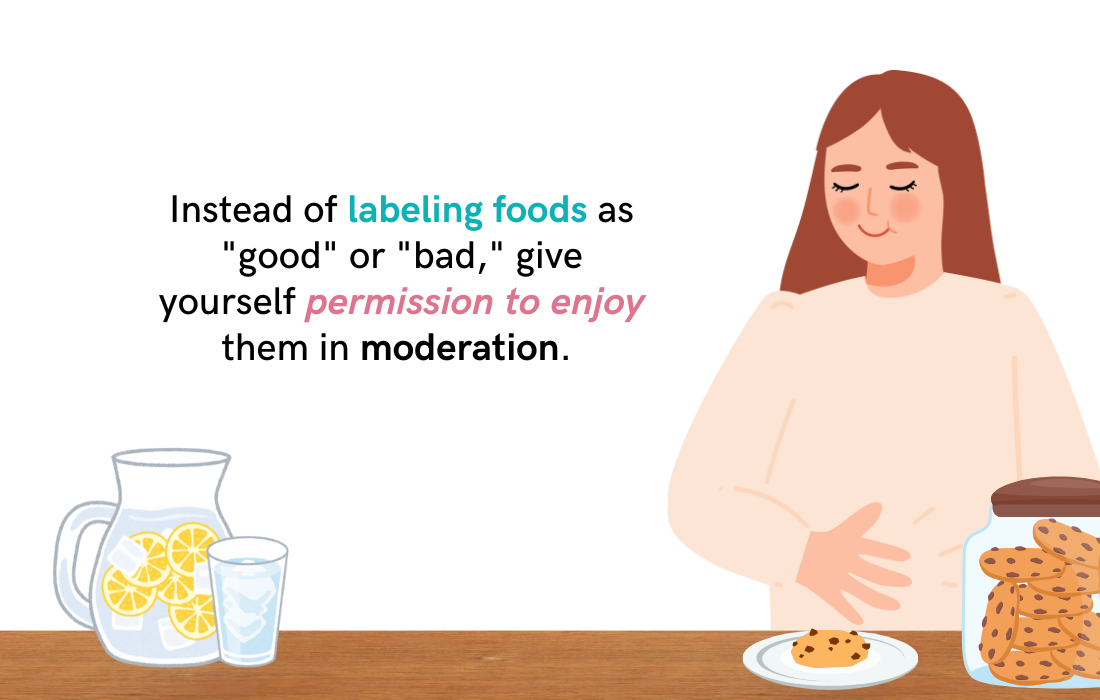
How to Figure Out Your Food Craving Triggers
Recognizing your personal triggers is the first step in managing cravings.
Common triggers include emotional eating patterns, stress, boredom, habit, and restrictive dieting. Keep a simple food journal to track when cravings hit—do they happen at certain times of day, after stressful meetings, or when you’re feeling lonely?
Once you identify patterns, you can work on alternative coping strategies, like deep breathing, calling a friend, or choosing a healthy snack instead of turning to food automatically.
For a lot of people food cravings happen at night (this was true for me — I called it the witching hour!)
The day is done and we’d sit down on the couch and then start to hear the cookies or ice cream call our name. What helped me was planning a pattern interrupt. If my usual pattern was to finish the dishes and then sit down on the couch, I switched it up.
I took a shower, journaled, wrote down to-do’s for the next day, or made a cup of tea and went upstairs to see if I could “interrupt” the eating habits. This allowed me space to see if I was hungry or escaping an emotion I didn’t want to feel.
How to Get Back on Track After Overindulging
Overeating happens—it’s normal! Instead of beating yourself up, focus on your next meal or snack, making sure it includes balanced, nourishing foods.
Drinking water, planned balanced meals, and getting back to your regular eating habits will help reset your body. Restricting food intake to “make up” for overeating often leads to more cravings and bingeing, so practice self-compassion and move forward without guilt.
One of my favorite mantras from my time in Overeaters Anonymous was “stay in today.”
Usually when we eat too much, we fixate on how to stop this problem for the rest of our lives. And since that’s too big for our minds to deal with, we feel hopeless and awful about ourselves, which can then lead to more eating.
But when we can use the “stay in today” mantra, we refocus on this meal, this moment, this day, which helps bring it down to something tangible and manageable.
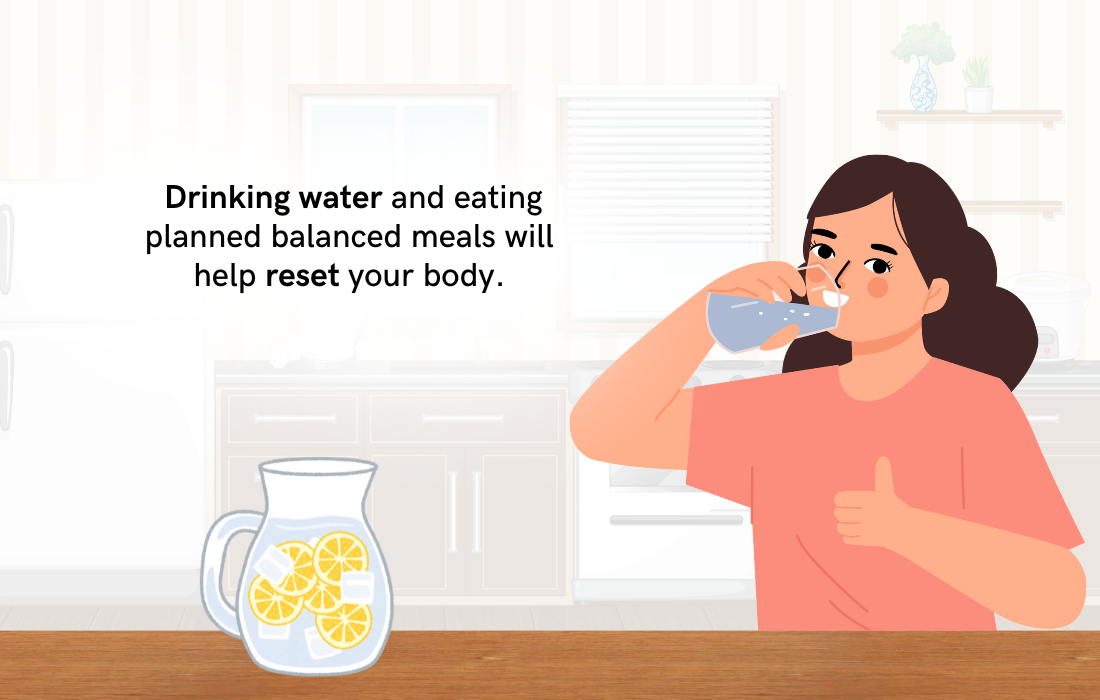
Common Questions about Dealing with Food Cravings
What is the root cause of most food cravings?
Food cravings can stem from a combination of physical, emotional, and habitual factors, including stress, restrictive dieting, and emotions. Understanding the underlying cause can help you address cravings in a balanced way rather than simply resisting them.
Why do I crave certain foods at night?
Nighttime cravings are often linked to not eating enough earlier in the day, emotional triggers like stress or loneliness, or simply habit. Ensuring you eat enough throughout the day and addressing emotional needs can help reduce late-night cravings.
How long do food cravings last?
Most cravings last between a few minutes to 20 minutes, though they can feel much stronger if you’re overly hungry or emotionally triggered. Distracting yourself, eating a balanced meal, or allowing yourself a mindful portion of what you’re craving can help manage them.
Can food cravings be a sign of a nutrient deficiency?
In some cases, yes—certain cravings may indicate a need for specific nutrients, like craving chocolate for magnesium or red meat for iron.
If your food intake is insufficient or if you body isn’t properly digesting and absorbing nutrients from your foods, then you may have a nutrient deficiency. However, cravings are complex and can also be driven by emotions, habits, and diet-based food restrictions.
What are the most common food cravings, and what do they mean?
Common cravings include sweets, salty snacks, carbs, and fatty foods, which may be linked to energy needs, stress, or even emotional comfort. Rather than just resisting cravings, exploring what your body and mind truly need can help you respond more effectively. Sometimes “healthy snacks” can also help to satisfy what we desire.
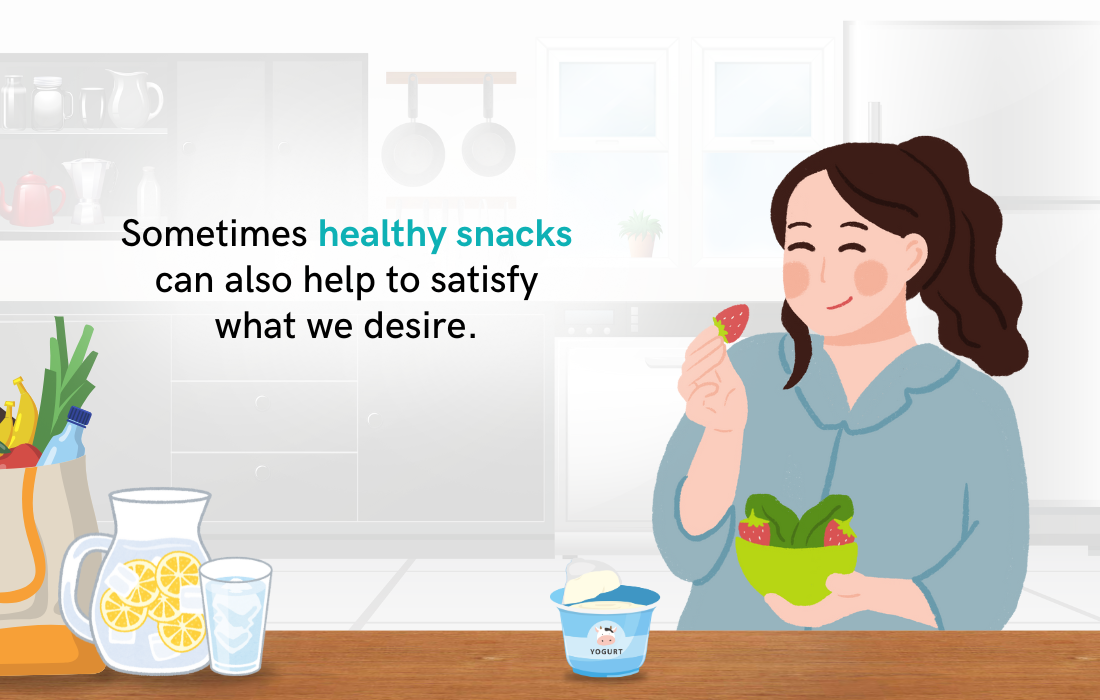
Can food cravings trigger emotional eating or binge eating?
Yes, intense cravings can sometimes lead to emotional eating or bingeing, especially if they’re caused by restriction, stress, or unmet emotional needs. Learning to balance cravings with mindfulness and flexibility can help prevent them from spiraling into binge episodes.
What does it mean if I’m often craving high calorie foods?
Frequent cravings for high-calorie foods could indicate that your body needs more energy, you’re undereating, or you’re using the foods for an emotional reasons like comfort and reward.
Should I be aiming to reduce food cravings? Or are food cravings normal and natural?
Food cravings are completely normal and a natural part of eating! Instead of trying to eliminate them, the goal is to approach them with balance—honoring cravings when they arise while also ensuring you’re nourishing your body well overall.
Is binge eating disorder related to having too many food cravings?
While cravings can play a role in binge eating, binge eating disorder is more complex and often involves emotional triggers, restriction, and underlying psychological factors. Learning to navigate cravings without fear or restriction can be an important step in healing from binge eating.
Is there such a thing as emotional eating types?
There are different emotional eating types, including stress eaters, boredom eaters, comfort eaters, reward eaters, fatigue eaters, and anxiety eaters. Each type is driven by specific emotions or habits, leading to cravings for certain foods.
Recognizing these patterns helps in developing healthier coping strategies and breaking the cycle of emotional eating. Just make sure you don’t give yourself a permanent label. You CAN overcome emotional eating, and you won’t be stuck forever!
Related Articles
⚪ How to Stop Overeating: 27 Things I’ve Done that Work
⚪ Recovering from Binge Eating: What to Do and How to Feel Better
⚪ Why Am I Always Thinking About Food?
Get the Normal Eater’s Newsletter
Join 8000+ women who are overcoming overeating, binge eating, and breaking up with dieting forever. Get Jenn’s inspiring and actionable weekly newsletter with the latest posts, podcasts, and tips on how to love your body, find food freedom, and lose weight holistically.
Get the Normal Eater’s NewsletterWork with an Emotional Eating & Holistic Nutrition Coach
Overcome Bingeing and Emotional Eating and Break Up with Yo-yo Dieting
Working with an emotional eating coach and holistic nutritionist can help you get free from the frustrating binge and restrict cycle and stop yo-yo dieting.
You don’t have to be obsessed with food or have a million rules around eating to find your natural weight and learn to love your body. Ready to actually see a lasting change and experience true freedom?
Schedule a 20-min CallAbout the Author:

Jenn Hand has been helping women like you become normal eaters since 2015.
She’s worked with thousands of women, helping them to balance their bodies, end bingeing, stop obsessing over food, and start feeling amazing again. As a board-certified health coach and holistic nutritionist, Jenn knows how to support you in making real positive changes that last.
Her articles have been published on Mind Body Green, Tiny Buddha, Thrive Global and other local and global media platforms. She’s the author of How to Be a Normal Eater and the creator of The Normal Eater’s Club program. Listen to Jenn’s advice and tips on the Cake Doesn’t Count Podcast, or read more of her articles for free on the Food Freedom Blog.
Learn About Coaching!
